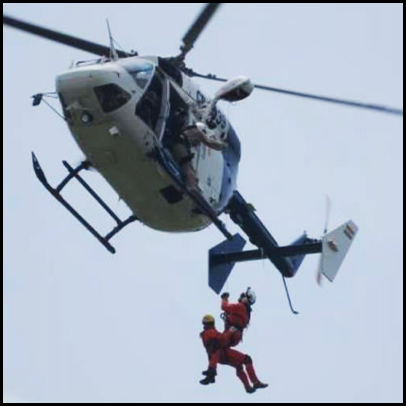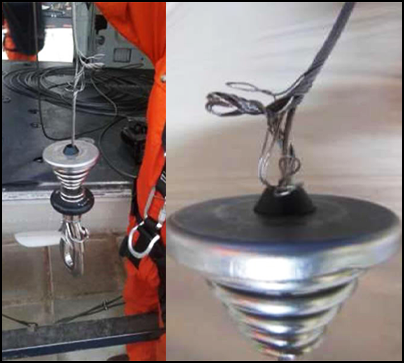-
What happened?
A helicopter was sent to evacuate a team from a remote location.
The safest option to recover the people was to use the hoist system.
The helicopter used the hoist to recover 4 people.
It was then asked to recover a second team of 6 people, using the same hoist.
After using the hoist, the helicopter crew noticed that the cable was damaged at its far end, near the hook handle.
The hoist was taken out of service.

-
Why did it happen?
Insufficient planning for the operation (prior aerial scouting, ensuring optimal radio network in remote areas and sufficient helipads/drop zones).
The hoist had 3 weeks left on its validity certificate but had performed an over average number of hoists (64 cycles out of the 500 recommended by manufacturer).
The aviation representative onsite did not verify the hoist installation or maintenance on the day of the incident.
Lack of clarity amongst management around rescue method and responsibilities.
No internal procedure for hoist operations or maintenance.

-
What did they learn?
Hoisting people should only be used in case of emergency, if approved by the relevant authority, by competent people and if the hoist system has been maintained in line with manufacturers’ procedures.
All crew should be trained in using the hoist. The hoist training syllabus should be reviewed before starting any operations.
Best industry practice should be followed:
Lifting of people should be avoided unless the risk is as low as reasonably practicable (ALARP).
Hazard assessments are integral to the lift planning process.
One person in the lift team is designated as in charge.
Everybody is trained and competent to perform their role.
Equipment is fit for purpose, thoroughly examined, and regularly maintained.
All lifting devices should be visually inspected before each use.

-
Ask yourself or your crew
Have you ever been in a situation like this?
What are the safe working procedures for hoisting?
Do you have a designated person in charge? Who is it?
Is all the equipment you work with inspected before use? How do you know?

Add to homescreen
Content name
Select existing category:
Content name
New collection
Edit collection
What happened?
A helicopter was sent to evacuate a team from a remote location.
The safest option to recover the people was to use the hoist system.
The helicopter used the hoist to recover 4 people.
It was then asked to recover a second team of 6 people, using the same hoist.
After using the hoist, the helicopter crew noticed that the cable was damaged at its far end, near the hook handle.
The hoist was taken out of service.

Why did it happen?
Insufficient planning for the operation (prior aerial scouting, ensuring optimal radio network in remote areas and sufficient helipads/drop zones).
The hoist had 3 weeks left on its validity certificate but had performed an over average number of hoists (64 cycles out of the 500 recommended by manufacturer).
The aviation representative onsite did not verify the hoist installation or maintenance on the day of the incident.
Lack of clarity amongst management around rescue method and responsibilities.
No internal procedure for hoist operations or maintenance.

What did they learn?
Hoisting people should only be used in case of emergency, if approved by the relevant authority, by competent people and if the hoist system has been maintained in line with manufacturers’ procedures.
All crew should be trained in using the hoist. The hoist training syllabus should be reviewed before starting any operations.
Best industry practice should be followed:
Lifting of people should be avoided unless the risk is as low as reasonably practicable (ALARP).
Hazard assessments are integral to the lift planning process.
One person in the lift team is designated as in charge.
Everybody is trained and competent to perform their role.
Equipment is fit for purpose, thoroughly examined, and regularly maintained.
All lifting devices should be visually inspected before each use.
Ask yourself or your crew
Have you ever been in a situation like this?
What are the safe working procedures for hoisting?
Do you have a designated person in charge? Who is it?
Is all the equipment you work with inspected before use? How do you know?
A helicopter evacuated two teams (10 people) using a hoist system. After these hoists, it was noticed that the cable was damaged.










